Steel Products Prices North America
January Shipments and Supply of Steel Products Analysis
Written by David Schollaert
March 15, 2023
Total US mill shipments of steel products increased in January, recovering from a 23-month low the month prior. January’s shipments were the highest since last August and totaled 7.63 million tons, a 6.5% increase from December’s 7.17 million tons. Apparent supply also saw a month-on-month (MoM) increase in January, up 7.9% vs. the prior month.
This analysis is based on steel mill shipment data from the American Iron and Steel Institute (AISI) and import-export data from the US Department of Commerce (DOC). The analysis summarizes total steel supply by product from 2009 through December 2022 and year-on-year (YoY) changes.
The supply/demand differential remains in place, with supply still well ahead of demand. Apparent supply (domestic shipments plus imports) in January was more than 13% above domestic shipments totals, up 1.6 percentage points MoM.
Export totals rebounded, up nearly 23% over the same period, while imports decreased MoM, down 10.3% in January.
Domestic mill utilization averaged 72.2% through January, down 0.4 percentage points from December’s 72.5% and down 9.8% vs. the same year-ago period.
Prices fell rapidly once raw material availability adjusted to the shock from the war in Ukraine. They bottomed out in November as supply steadily outpaced demand. December pricing recovered slightly to close out the year and has accelerated with a staggering number of mill price hikes at the start of 2023, carrying into March.
SMU’s benchmark hot-rolled coil price rose by roughly $95 per net ton ($4.75 per cwt) in January. It peaked at $1,480 per ton in mid-April 2022 and had been declining since recovering through December. It has accelerated in Q1, increasing at an average of more than $30 per ton weekly since late November.
HRC prices closed out January at an average of $780 per ton FOB mill, east of the Rockies on Jan. 31, but have ballooned to $1,115 per ton on average, according to SMU’s latest check of the market on March 14, as mills continue to push prices higher on the back of a supply squeeze.
Raw steel production, shown below in Figure 1, is based on weekly data from the AISI. It is displayed here as four-week moving averages through Jan. 31.
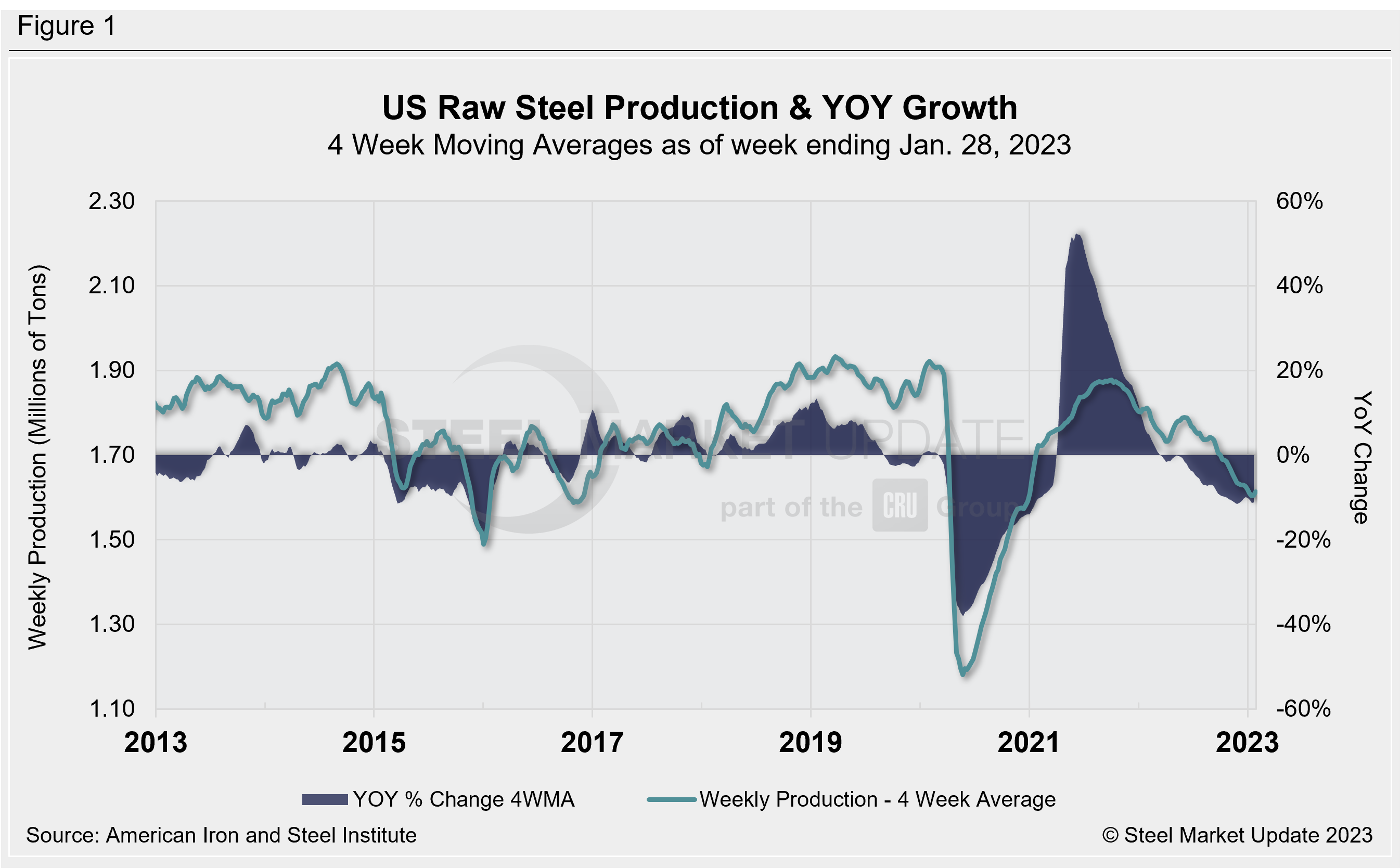
Monthly shipment data for all rolled steel products and exports are noted in Figure 2. Measured as a three-month moving average (3MMA) of the monthly data, the December total was 7.24 million tons, down 0.8% vs. 7.29 million tons in December. Monthly shipments have increased only once monthly YTD for the 3MMA analysis. Shipments declined 14.3% in January vs. the year prior when shipments were 8.45 million tons. The recovery from Covid-related shutdowns more than two years ago was meaningful. January’s shipments were more than 17% below the same pre-pandemic period in 2020.
All rolled product exports totaled 750,685 tons in January, up 23.6% MoM and 5.8% higher vs. the same year-ago period. January’s total is the highest total since August 2022.
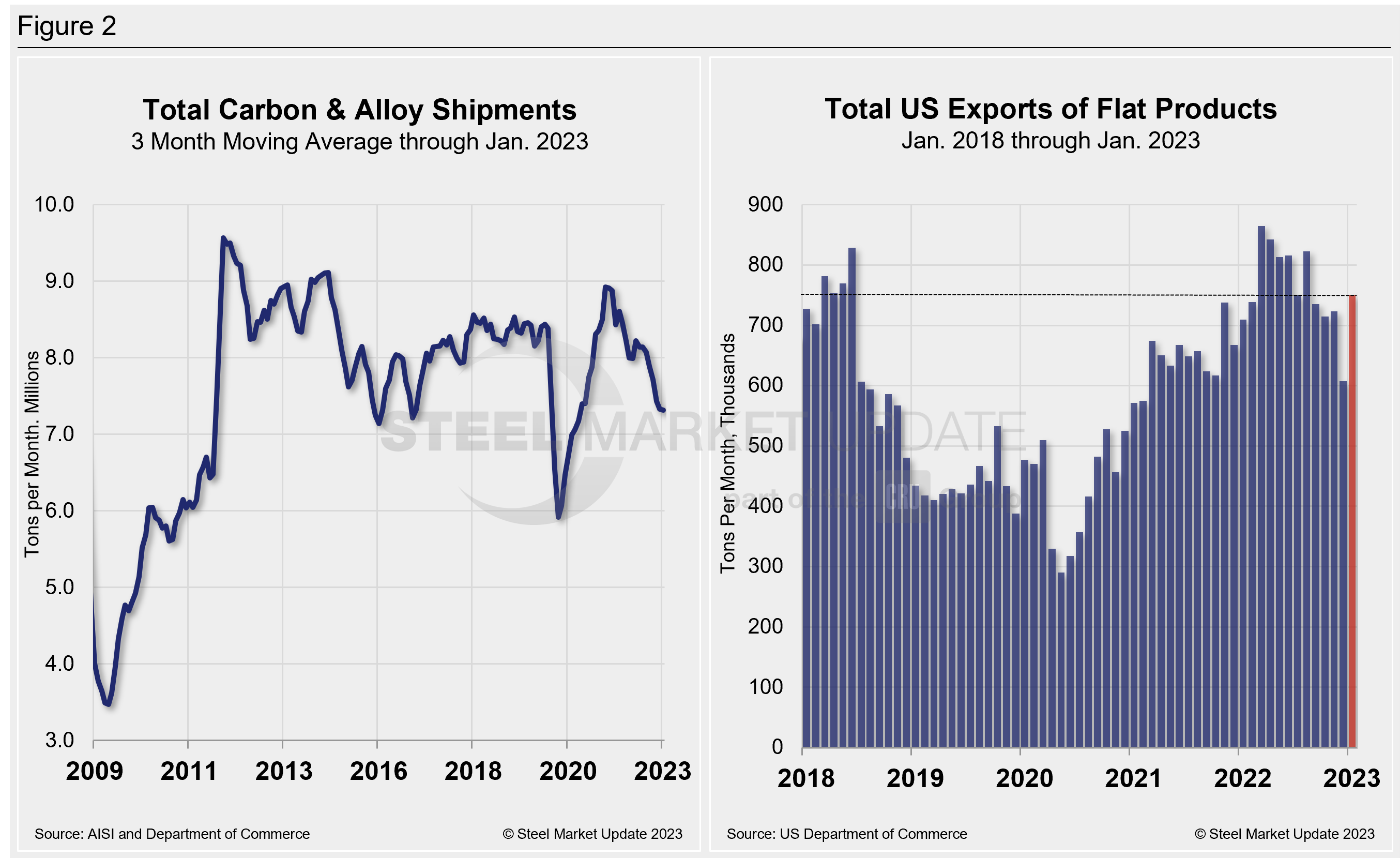
Shipment and supply details for all product groups and individual sheet products are noted in Table 1. Domestic supply (shipments and imports) is shown in Table 2. Total supply (a proxy for market demand) as a 3MMA was down YoY in January, and well behind the 25% growth seen the year prior when the market was well beyond the Covid shutdowns and toward historic highs.
Apparent supply is defined as domestic mill shipments to domestic locations plus imports. Mill shipments were down more than 14%, and a far cry from the 14.2% growth seen during the year-ago period in the same 3MMA comparison. The bright spots are tubular goods and plate products.
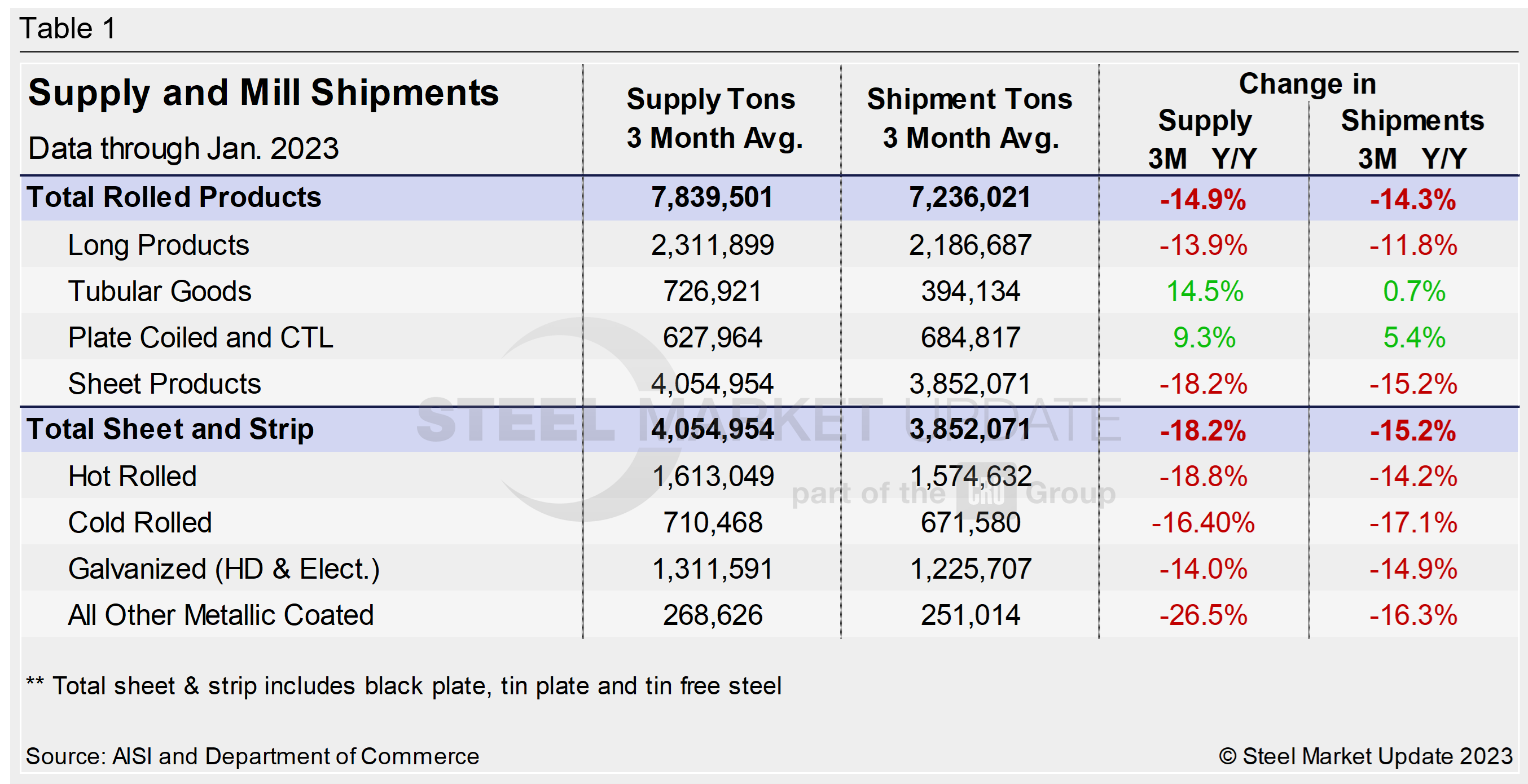
Total sheet and strip apparent supply is down YTD (Table 2) compared to 2022 and is similarly lower over the past three months. The same can be said for total rolled product apparent supply, which is notably down over the past 12 months on a 3MMA basis, and down over the same year-ago period. Note that YoY comparisons have seasonality removed.
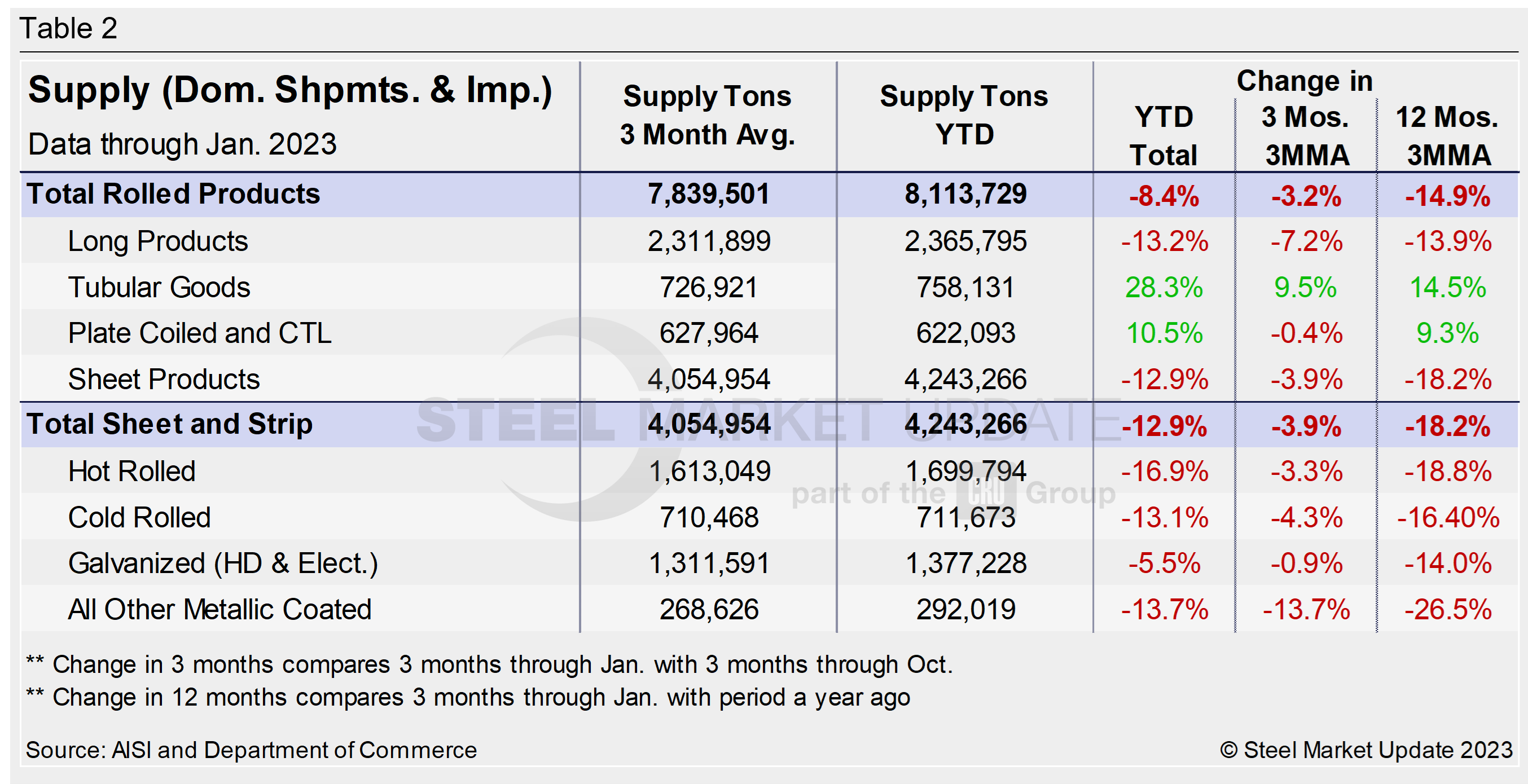
The supply picture for HRC, CRC, and HDG since January 2009 as three-month moving averages vs. the long-term comparison between flat and long products is shown side by side in Figure 3. On the left chart, all three sheet products are displayed. They had experienced some improvement since mid-2020 but have now been trending downward through January. When compared to the same pre-pandemic period in 2020, all three are down. Supplies of hot rolled have seen the largest percentage decline (-18.8%), followed by cold rolled (-18.2%), and galvanized (hot dipped and electrolytic: -11.5%), from the same pre-pandemic period in 2020. In the right chart, note that these are monthly numbers (not 3MMAs), which show the trend difference between long and flat products, including plate.
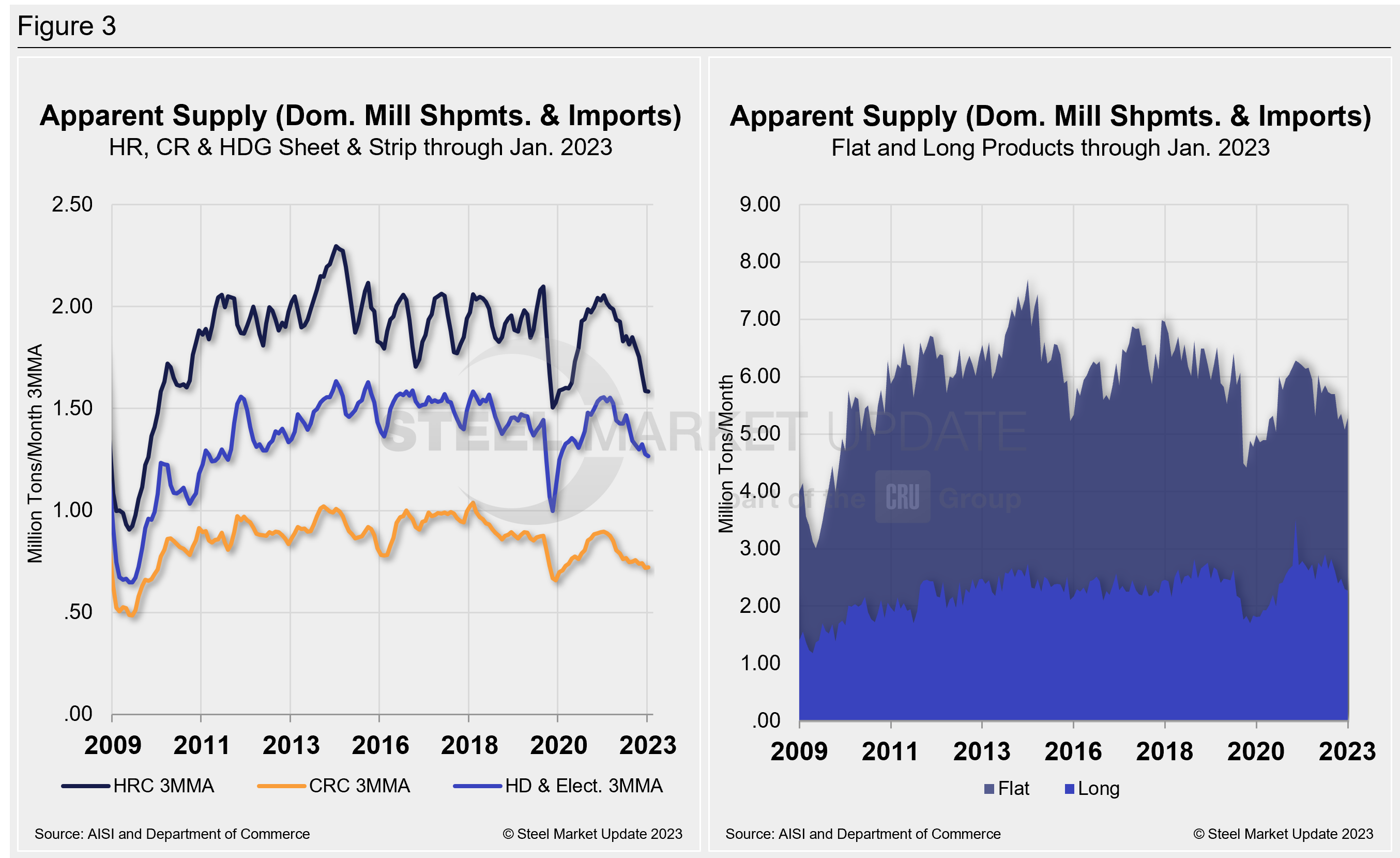
By David Schollaert, david@steelmarketupdate.com

David Schollaert
Read more from David SchollaertLatest in Steel Products Prices North America

Nucor maintains plate prices, opens August order book
Nucor aims to keep plate prices flat again with the opening of its August order book.

Nucor CSP remains level at $900/ton
Nucor maintained its weekly list price for hot-rolled (HR) coil this week, following two consecutive increases.

Cliffs raises prices, seeks $950/ton for July spot HR
Cleveland-Cliffs plans to increase prices for hot-rolled (HR) coil to $950 per short ton (st) with the opening of its July spot order book. The Cleveland-based steelmaker said the price hike was effective immediately in a letter to customers dated Monday.

HRC vs. prime scrap spread widens in June
The price spread between HRC and prime scrap widened in June.

SMU price ranges: Steel prices rise in response to tariffs
Steel prices climbed for a second straight week across all five sheet and plate products tracked by SMU.
